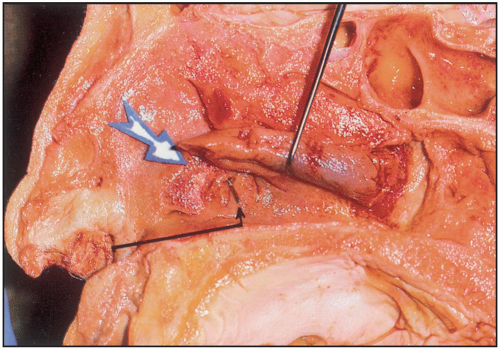Intranasal
The purpose of these dissections relates to two subjects:
1 The relation and course of the nasolacrimal apparatus into the nose.
2 How to perform a sphenopalatine (pterygopalatine) ganglion block, which accomplish the following:
Reduces tear production.
Blocks mucosa of the posterior superior and middle conchae, the nasal septum, the roof of the nasal cavity, and much of the nasal floor forward to the incisor foramen.
Numbs the palate (hard and soft).
2a The opening for the nerve behind the middle turbinate can also be approached by a “cocainized” pledget placed 7 to 8 cm inside the nose. The exact placement of this anesthetic pledget is usually difficult because of the turbinate size and anatomic variations.
 Figure 7F.1 A probe is passed from the lacrimal sac region into the nose to exit under the front of the inferior turbinate. The turbinate has been released anteriorly to show this. |
 Figure 7F.2
Stay updated, free articles. Join our Telegram channel
Full access? Get Clinical Tree
 Get Clinical Tree app for offline access
Get Clinical Tree app for offline access

|